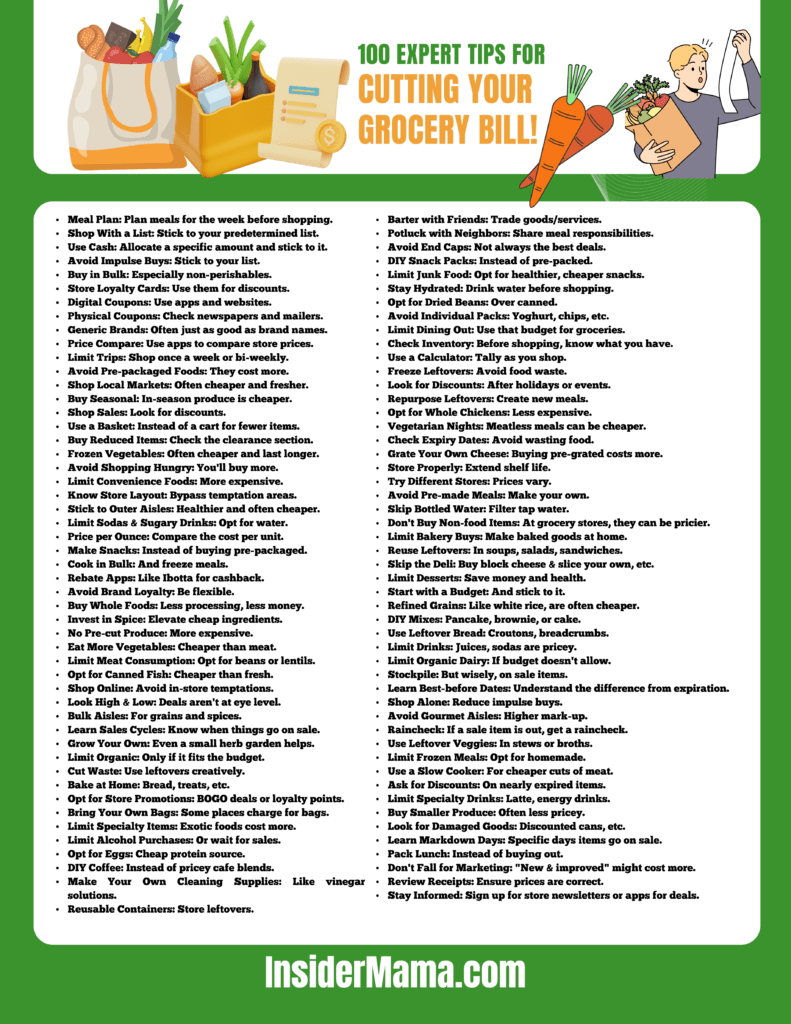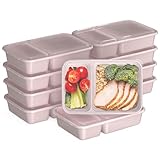Moms understand the importance of keeping their families well-fed, happy, and healthy without breaking the bank. I understand the challenge of making the most of every dollar spent when shopping at the grocery store. Today, I will share my proven strategies for grocery shopping on a tight budget. I have gained these tips through years of experience and countless shopping trips.
This site includes affiliate links; you can check the disclosure for more details.
Plan Before You Shop: Grocery Shopping on a Tight Budget
- Start with a list: Before you head to the store, take a moment to think about what you really need. Make a list of essentials and stick to it. This little bit of prep can save you from impulse buys.
- Meal prep magic: Plan your meals for the week. This way, you know exactly what ingredients you need, and it stops you from buying things that will just sit in the fridge.
Be a Smart Shopper
- Store brands are your friends: Don’t shy away from store brands. They’re often just as good as name brands but cheaper.
- Sales and discounts are lifesavers: Keep an eye out for sales and use coupons. Also, many stores have loyalty programs that can save you a pretty penny.
- Buy in bulk, but wisely: Bulk buying can save money when you’re grocery shopping on a tight budget, but only buy what you can use before it goes bad. It’s not a deal if you end up throwing it away.
Fresh, Frozen, or Canned?
- Seasonal produce is the way to go: Seasonal fruits and veggies are usually cheaper. They’re fresh and packed with flavor too!
- Frozen and canned are okay too: Don’t overlook the frozen aisle. Frozen fruits and veggies can be just as nutritious as fresh ones. Canned goods are also a budget-friendly option.
Reduce Waste
- Leftovers are your secret weapon: Get creative with leftovers. They can be turned into an entirely new meal.
- Check what you have first: Before you shop, see what you already have. You might be surprised by what’s hiding in your pantry or freezer.
Grocery Shopping on a Tight Budget: Where and When You Shop Matters
- Local markets can be goldmines: Local farmers’ markets often have great deals on produce. Plus, you’re supporting local farmers!
- Time your shopping trips: Sometimes, shopping in the evening can score you some discounts, especially on perishable items like bakery and produce.
Tips for Grocery Shopping on a Tight Budget
Meal Planning and Preparation
- Meal Plan: Plan meals for the week before shopping.
- Shop With a List: Stick to your predetermined list.
- Use Cash: Allocate a specific amount and stick to it.
- Avoid Impulse Buys: Stick to your list.
- Limit Trips: Shop once a week or bi-weekly.
- Avoid Pre-packaged Foods: They cost more.
- Cook in Bulk: And freeze meals.
- Avoid Shopping Hungry: You’ll buy more.
Meal Prep Set
Bentgo’s 20-piece meal prep set makes healthy eating easy with portion-controlled, stackable trays and lids that keep food fresh. Durable, BPA-free, and microwave-safe, these containers are perfect for on-the-go meals and eco-friendly convenience.
Smart Shopping Strategies
- Buy in Bulk: Especially non-perishables.
- Store Loyalty Cards: Use them for discounts.
- Digital Coupons: Use apps and websites.
- Physical Coupons: Check newspapers and mailers.
- Generic Brands: Often just as good as brand names.
- Price Compare: Use apps to compare store prices.
- Shop Sales: Look for discounts when grocery shopping on a tight budget.
- Use a Basket: Instead of a cart for fewer items.
Produce and Protein Savings
- Buy Seasonal: In-season produce is cheaper.
- Frozen Vegetables: Often cheaper and last longer.
- Limit Meat Consumption: Opt for beans or lentils.
- Opt for Canned Fish: Cheaper than fresh.
- Vegetarian Nights: Meatless meals can be cheaper when you’re grocery shopping on a tight budget.
- Eat More Vegetables: Cheaper than meat.
Shopping Techniques
- Know Store Layout: Bypass temptation areas.
- Stick to Outer Aisles: Healthier and often cheaper.
- Price per Ounce: Compare the cost per unit.
- Make Snacks: Instead of buying pre-packaged.
- Look High & Low: Deals aren’t at eye level.
- Bulk Aisles: For grains and spices.
- Learn Sales Cycles: Know when things go on sale.
Storage and Waste Reduction
- Store Properly: Extend shelf life.
- Freeze Leftovers: Avoid food waste.
- Cut Waste: Use leftovers creatively.
- Use Leftover Bread: Croutons, breadcrumbs.
- Reuse Leftovers: In soups, salads, sandwiches.
- Repurpose Leftovers: Create new meals.
Beverage and Snack Tips: Grocery Shopping on a Tight Budget
- Limit Sodas & Sugary Drinks: Opt for water.
- DIY Coffee: Instead of pricey cafe blends.
- Stay Hydrated: Drink water before shopping.
- Limit Specialty Drinks: Latte, energy drinks.
- Limit Junk Food: Opt for healthier, cheaper snacks.
- Limit Desserts: Save money and health.
Budget-Friendly Grocery Habits
- Start with a Budget: And stick to it.
- Rebate Apps: Like Ibotta for cashback.
- Avoid Brand Loyalty: Be flexible.
- Buy Whole Foods: Less processing, less money.
- Invest in Spice: Elevate cheap ingredients.
- Shop Online: Avoid in-store temptations.
Savings on Non-Food Items
- DIY Cleaning Supplies: Like vinegar solutions.
- Reusable Containers: Store leftovers.
- Don’t Buy Non-food Items: At grocery stores, they can be pricier.
- Bring Your Own Bags: Some places charge for bags.
- Barter with Friends: Trade goods/services.
Discount Hunting: Grocery Shopping on a Tight Budget
- Buy Reduced Items: Check the clearance section.
- Opt for Store Promotions: BOGO deals or loyalty points.
- Learn Markdown Days: Specific days items go on sale.
- Ask for Discounts: On nearly expired items.
- Look for Damaged Goods: Discounted cans, etc.
- Raincheck: If a sale item is out, get a raincheck.
Creative Cooking Ideas
- Bake at Home: Bread, treats, etc.
- DIY Mixes: Pancake, brownie, or cake.
- Make Your Own Snack Packs: Instead of pre-packed.
- Opt for Whole Chickens: Less expensive.
- Use Leftover Veggies: In stews or broths.
Shopping Environment Strategies
- Avoid End Caps: Not always the best deals.
- Limit Alcohol Purchases: Or wait for sales.
- Skip Bottled Water: Filter tap water.
- Avoid Pre-made Meals: Make your own.
- Avoid Gourmet Aisles: Higher mark-up.
Final Tips for Grocery Shopping on a Tight Budget
- Stay Informed: Sign up for store newsletters or apps for deals.
- Pack Lunch: Instead of buying out.
- Use a Calculator: Tally as you shop.
- Check Expiration Dates: Avoid wasting food.
- Review Receipts: Ensure prices are correct.

Mastering grocery shopping on a tight budget is all about making smart choices before, during, and after your trip to the store. By planning your meals, sticking to a list, taking advantage of discounts, and being mindful of waste, you can significantly cut down on costs without sacrificing quality or nutrition. With these practical tips, you’ll find that it’s entirely possible to eat well and save money at the same time.





